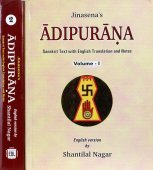Apabhramsha, Apabhraṃśa: 16 definitions
Introduction:
Apabhramsha means something in Hinduism, Sanskrit, the history of ancient India, Marathi, Hindi. If you want to know the exact meaning, history, etymology or English translation of this term then check out the descriptions on this page. Add your comment or reference to a book if you want to contribute to this summary article.
Apabhramsha has 15 English definitions available.
The Sanskrit term Apabhraṃśa can be transliterated into English as Apabhramsa or Apabhramsha, using the IAST transliteration scheme (?).
Alternative spellings of this word include Apbhransh.
Languages of India and abroad
Sanskrit dictionary
[Deutsch Wörterbuch]
Source: Cologne Digital Sanskrit Dictionaries: Böhtlingk and Roth Grosses Petersburger WörterbuchApabhraṃśa (अपभ्रंश):—und apabhraṃsa (von bhraṃś oder bhraṃs mit apa) m.
1) Herabfall [Trikāṇḍaśeṣa 3, 3, 425.] [Hemacandra’s Anekārthasaṃgraha 4, 310.] [Medinīkoṣa śeṣa (s. II.). 31.] anapabhraṃśa [Pañcaviṃśabrāhmaṇa 17, 4.] in [Weber’s Indische Studien I, 34, Nalopākhyāna] atyārūḍhirbhavati mahatāmapyapabhraṃsaniṣṭhā v. l. zu [Śākuntala 78.] —
2) falsche, von der Grammatik abweichende Sprache [Amarakoṣa 1, 1, 5, 2.] [Trikāṇḍaśeṣa] [Hemacandra’s Anekārthasaṃgraha 4, 309.] [Medinīkoṣa] —
3) Name einer bes. Sprache [Trikāṇḍaśeṣa] [Hemacandra’s Anekārthasaṃgraha] [Medinīkoṣa] Wird dem Prākṛt entgegengesetzt und in [4] Unterdialecte getheilt, [Scholiast] der [Mṛcchakaṭikā] bei [STENZLER, S. V.] Vgl. [Griechischen und Indoskythischen Könige, Institt. 10. fgg.] [Lassen’s Indische Alterthumskunde II, 1150.] [Weber’s Indische Studien II, 408.]
--- OR ---
Apabhraṃśa (अपभ्रंश):—
1) füge Sturz, Fall und [Taittirīyasaṃhitā 1, 5, 1, 2] (= dehapāta [Scholiast][?). WEBER, Nakṣ. 2, 387. Harivaṃśa 1014] hinzu. —
2) [Rājataraṅgiṇī 5, 205.] ekaikasya hi śabdasya bahavo pabhraṃśāḥ falsche Formen [Patañjali] in [MAHĀBH. 22.] —
3) [Kathāsaritsāgara 55,127.] [kāvyādarśa.1,32.] [Oxforder Handschriften 181,a, No. 412. 214,a, No. 509.] [WASSILJEW 226. 267.] Davon nom. abstr. tā f.: śāstreṣu saṃskṛtādanyadaprabhraṃśatayoditam [kāvyādarśa 1, 36.] [MUIR, Stenzler 2, 57.]
Source: Cologne Digital Sanskrit Dictionaries: Sanskrit-Wörterbuch in kürzerer FassungApabhraṃśa (अपभ्रंश):—m. —
1) Herabfall , Sturz. —
2) falsche sprachliche Form. —
3) ein best. gering geachteter Dialect. Dazu Nom.abstr. tā f.
Sanskrit, also spelled संस्कृतम् (saṃskṛtam), is an ancient language of India commonly seen as the grandmother of the Indo-European language family (even English!). Closely allied with Prakrit and Pali, Sanskrit is more exhaustive in both grammar and terms and has the most extensive collection of literature in the world, greatly surpassing its sister-languages Greek and Latin.
See also (Relevant definitions)
Partial matches: Bhramsha, Apa.
Starts with: Apabhramshamaya, Apabhramshanudi, Apabhramshate.
Ends with: Anapabhramsha.
Full-text (+340): Kadavaka, Apabhrashta, Upanagara, Vracada, Svayambhuchandas, Abdhimathana, Avappirancanam, Kalahatta, Svayambhu, Svayambhudeva, Apashabda, Shaurseni, Language, Vracata, Dhanadevu, Dhuttu, Gopotalika, Ajjadevu, Suddhasīlu, Chaillu.
Relevant text
Search found 23 books and stories containing Apabhramsha, Apabhraṃśa, Apabhramsa, Apa-bhramsha, Apa-bhraṃśa, Apa-bhramsa, Apabhraṃsa, Apa-bhraṃsa, Apabhramśa; (plurals include: Apabhramshas, Apabhraṃśas, Apabhramsas, bhramshas, bhraṃśas, bhramsas, Apabhraṃsas, bhraṃsas, Apabhramśas). You can also click to the full overview containing English textual excerpts. Below are direct links for the most relevant articles:
Kavyamimamsa of Rajasekhara (Study) (by Debabrata Barai)
Part 5.1 - Environment and Retreat of Kavi (poets) < [Chapter 5 - Analyasis and Interpretations of the Kāvyamīmāṃsā]
Part 8 - Rājaśekhara and Prākṛita Language < [Chapter 1 - Introduction]
Part 23 - The story of kāvya-puruṣa by Rājaśekhara < [Chapter 2 - A General Outlines of Sanskrit Poetics]
Bhakti-rasamrta-sindhu (by Śrīla Rūpa Gosvāmī)
Verse 2.1.67 < [Part 1 - Ecstatic Excitants (vibhāva)]
Amarakoshodghatana of Kshirasvamin (study) (by A. Yamuna Devi)
Education (4): Language and literature < [Chapter 4 - Cultural Aspects]
Musical instruments (e.g., Stringed, Percussions, Cymbals and Wind-blown) < [Chapter 4 - Cultural Aspects]
Education (5): Linguistic principles < [Chapter 4 - Cultural Aspects]
Bhagavati-sutra (Viyaha-pannatti) (by K. C. Lalwani)
Part 7 - On language of the gods < [Chapter 4]
Bodhisattvacharyavatara (by Andreas Kretschmar)
Text Section 136 < [Khenpo Chöga’s Oral Explanations]
A Common Heritage < [January – March, 1985]
Our Forum < [January-February 1931]
Reviews < [October - December 1974]
Related products
